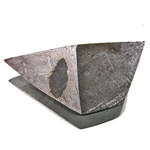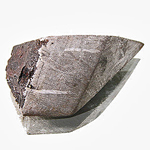Gibeon Meteorit
An iron meteorite of the Octahedrite class, the most common class of the iron meteorite group (nickel iron meteorites, to be exact).
Can be confused with: other iron meteorites
Distinct Widmanstaetten patterns on two Gibeon discs
Iron and nickel form homogeneous alloys at temperatures below the melting point, these alloys are taenite. At temperatures below 900 to 600°C (depending on the Ni content), two alloys with different nickel content are stable: kamacite with lower Ni-content (5 to 15% Ni) and taenite with high Ni (up to 50%). Octahedrite meteorites have a nickel content intermediate between the norm for kamacite and taenite, this leads under slow cooling conditions to the precipitation of kamacite and growth of kamacite plates along certain crystallographic planes in the taenite crystal lattice.
The formation of Ni-poor kamacite proceeds by diffusion of Ni in the solid alloy at temperatures between 700 and 450°C, and can only take place during very slow cooling, about 100 to 10,000 °C/Myr, with total cooling times of 10 Myr or less. This explains why this structure cannot be reproduced in the laboratory.


The dark mottled areas are called plessite.
Chemical composition: 91,8 % iron; 7,7 % nickel; 0,5 % cobalt; 0,04 % phosphor; 1,97 ppm gallium; 0,111 ppm germanium; 2,4 ppm iridium
 Deutsch
Deutsch